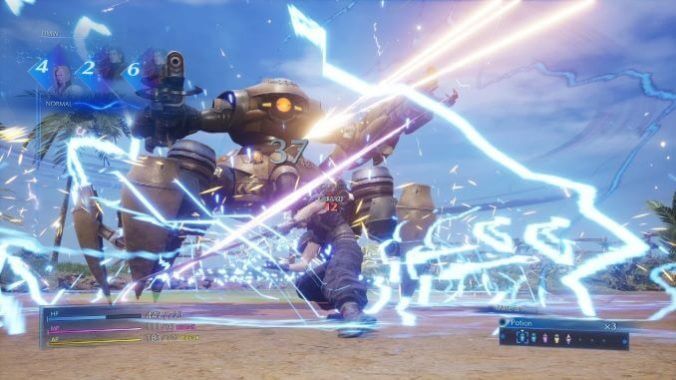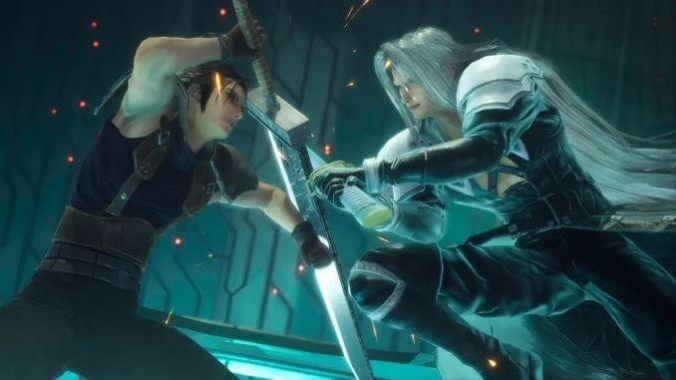Crisis Core Final Fantasy VII Reunion continues Square Enix’s trend of creating mind-meltingly long and stupid titles for their remakes, remasters and reimaginings of all things Final Fantasy VII, with this title being the second of the three. A remaster of the 2007 (2008 outside of Japan) PlayStation Portable game, what I’ll from now on refer to as Crisis Core Reunion aims to create a solid, modern version of the game for every platform under the sun, no doubt due to Final Fantasy VII’s increased relevance thanks to Square Enix’s ongoing remake series of the title.
By that metric, the company certainly succeeded. Crisis Core Reunion takes what used to be confined to the old, unpopular handheld device and not only ports it to every platform you could hope for, but also updates the graphics considerably from their original grainy aspect ratio. Assuredly a remaster and not a remake, there are no major (or even minor, from what I can tell) changes to the game’s script or scenarios, unlike 2020’s Final Fantasy VII Remake, which essentially creates a new timeline for the series to follow.
As I never owned a PSP and I’m a new fan of Final Fantasy VII thanks to the remake, I never experienced Crisis Core when it originally came out. As such, I’m judging a portable game from 2007 by the standards of playing a console game in 2022. Given the circumstances, Crisis Core Reunion stands on its own pretty well. But judged by its own merits in the present day, the game fares less favorably.
The game stars Zack Fair (Caleb Pierce), a young and overly energetic member of the nefarious Shinra’s SOLDIER program, where the strongest members of the company do its bidding. Although Shinra is definitely led by Bad Guys, the blame is shielded from Zack as he just tries to do his best without knowing the shady stuff his bosses are up to.
There are two parts of Crisis Core’s story. The first part is the stuff with the cast of Final Fantasy VII, including Zack hanging out and completing missions with Aerith (Briana White), Cloud (Cody Christian) and a pre-evil Sephiroth (Tyler Hoechlin), among others. Although “completing missions” with Aerith means doing a long quest in order to build the dinkiest little flower wagon whereas with Cloud, Sephiroth and the gang it means fighting enemies, it’s all mostly interesting stuff that builds out these beloved characters’ backstories and motivations prior to the events of Final Fantasy VII.

The second part, which takes up a larger percentage of the game than I’d have liked, deals with characters that seem new to me, especially the game’s main antagonists, Angeal (Bill Millsap) and Genesis (Shaun Conde). Both sprout single giant wings out of their backs, which of course means they’re evil now and they have to fight Zack and the rest of Shinra (even though Shinra is also evil… look, it’s confusing). I feel like some of this story might have made more sense had I played through the original Final Fantasy VII, but as is, there was a lot of stuff that just flew right over my head and devolved into a lot of nonsense.
The gameplay is comparatively simple, feeling a lot like the combat from Final Fantasy VII Remake even though Crisis Core obviously came first. There isn’t the cool mechanic from the remake where you can stop time to choose from a series of moves, but you’re still able to attack and dodge in real time while choosing from various spells and special moves you can upgrade and swap out with materia as time goes on. It didn’t blow me away, but combat was mostly unchallenging yet engaging throughout, aside from one point where I had to grind out a few side quest missions to progress.
I call it grinding because that’s really what the side quests feel like. There’s little to no story to contextualize why you’re doing what you’re doing. You just fight a bunch of enemies in a separate liminal space until they’re all gone. There are a lot of these quests, but they’re all optional and aside from that one point, I never felt underleveled from not doing them.
I was also let down by the game’s ending, which I had heard from many was the best part of the game. After heading in one direction for hours, the game’s final few minutes shifts somewhere entirely different. I won’t spoil what happens, but it’s almost entirely cutscenes and seems like an abrupt ending that didn’t hit me emotionally in the way I think it was intended to.
Overall, I enjoyed Crisis Core Reunion’s 10-ish-hour story well enough, and I’m grateful to know more about Zack before his anticipated reappearance in Final Fantasy VII Rebirth. Unfortunately, the game’s age shows, with the random encounters and constricted corridors designed for a handheld released in 2004 not holding up as well on modern platforms in 2022.
Crisis Core Final Fantasy VII Reunion was developed by Tose and Square Enix and published by Square Enix. Our review is based on the PlayStation 5 version. It is also available for the Switch, Xbox Series X|S, PC, Xbox One, and PlayStation 4.
Joseph Stanichar is a freelance writer who specializes in videogames and pop culture. He’s written for publications such as Game Informer, Twinfinite and Looper. He’s on Twitter @JosephStanichar.

